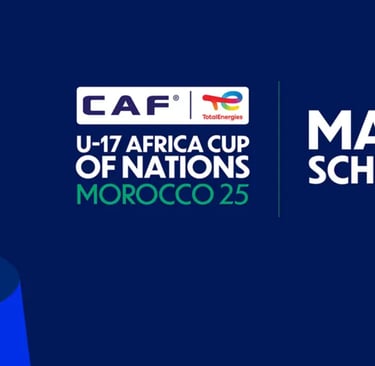Quarter-Final Match Report: Morocco U-17 vs South Africa U-17
Quarter-Final Match Report: Morocco U-17 vs South Africa U-17
SPORT
4/12/20257 min read


Introduction
The quarter-final match between Morocco U-17 and South Africa U-17 in the CAF U-17 Africa Cup of Nations represents a pivotal moment for both teams. This tournament serves as a platform for young footballers to showcase their talents and potentially secure a future in professional football. As the host nation, Morocco carried the weight of expectation from its supporters, who anticipated a strong performance on home soil. This clash was significant not only for the teams involved but also for the larger regional football narrative, as both nations aimed to further their aspirations in this prestigious tournament.
Morocco, with its rich footballing culture and investment in youth development, entered the match with the hopes of making a deep run into the competition. The players were well aware that their performances would not only affect their journey in the tournament but also shape the footballing landscape within the country. Conversely, South Africa's U-17 team sought to prove itself on the continental stage, aiming to disrupt the expectations placed on the hosts and advance further in the tournament.
The matchday atmosphere was charged, with an enthusiastic crowd that filled the stadium to support the Moroccan team. The expectations were palpable, as fans believed that the combination of local support and the squad's talent could lead to a satisfying result. Both teams showcased their determination to advance, indicating the match would be a closely contested affair. With a place in the semi-finals at stake, this quarter-final encounter was poised to be a thrilling display of youth football, as each team sought to make its mark in the CAF U-17 Africa Cup of Nations.
First Half Analysis
In the quarter-final match between Morocco U-17 and South Africa U-17, the first half exhibited a captivating display of youthful talent, with Morocco taking the initiative from the outset. From the first whistle, Morocco showcased their attacking prowess, dominating possession and pressing high up the pitch. Their early dominance was evident as they effectively controlled the midfield, allowing for quick transitions from defense to attack.
The breakthrough for Morocco arrived shortly after the fifteenth minute, when Ismail El Aoud brilliantly capitalized on a defensive lapse from South Africa. His well-placed shot from the edge of the box found the back of the net, sending a wave of excitement through the Moroccan camp. This goal underscored Morocco's strategic approach, as they focused on exploiting spaces left by the South African defenders. El Aoud’s ability to read the game and position himself effectively allowed Morocco to establish early momentum in the match.
The remainder of the first half continued to reflect the tactical battle, with Morocco applying constant pressure, while South Africa struggled to find their rhythm. Despite their efforts, the South African side could not find an answer to Morocco’s pressing game, concluding the first half with Morocco ahead and showing a strong potential for securing a place in the semifinals.
Second Half Dynamics
The second half of the quarter-final match between Morocco U-17 and South Africa U-17 showcased a significant shift in dynamics as South Africa altered their strategy to seek a path to victory. Early in the period, South Africa displayed tenacity and a more aggressive approach, which paid off when Neo Daniel Bokgoth found the back of the net. His goal not only elevated the morale of the South African squad but also served as a stark indicator of their improved performance in the second half. This pivotal moment was a culmination of well-coordinated teamwork and tactical adjustments that had been made during halftime.
In response to Bokgoth's impressive strike, Morocco U-17 faced the challenge of regrouping and reassessing their game plan. The Moroccan side, already demonstrating skill and finesse in the first half, now found themselves needing to dig deeper into their tactical repertoire. Realizing the urgency of the situation, they adopted a more aggressive pressing strategy to regain control of possession and mitigate South Africa’s attacking momentum. This realignment emphasized both their defensive strengths and their ability to transition quickly into offensive plays.
As the half progressed, Morocco began to regain composure, utilizing their creative midfielders to orchestrate plays that could breach the South African defense. They expertly maneuvered the ball to exploit gaps, aiming to reassert their dominance in the match. Consequently, the final segment of the second half morphed into a tactical tug-of-war, marked by both teams vying for control and searching for additional goals that would seal their trajectory in the tournament. The intensity of the contest amplified with thrilling plays that encapsulated the essence of competitive youth football, further emphasizing the unpredictability and excitement that such matches often bring.
Key Players and Performances
The quarter-final match between Morocco U-17 and South Africa U-17 showcased several key players whose performances significantly influenced the outcome of the game. Among them, Ismail El Aoud stood out for Morocco, exhibiting remarkable skill and tactical awareness. His ability to control the midfield allowed Morocco to dictate the pace of the game. El Aoud's passing accuracy and vision were evident when he completed multiple key passes that penetrated the South African defense, setting up several goal-scoring opportunities for his teammates. His solid performance was crucial in maintaining Morocco's attacking momentum throughout the match.
Another noteworthy player was Ziyad Baha Abelhadj, who played a pivotal role in Morocco's defensive lineup. His ability to read the game and intercept passes disrupted South Africa’s attacking plays on numerous occasions. Abelhadj's strong physical presence and aerial prowess in defending set pieces contributed to his team's stability at the back. Not only did he excel defensively, but he also supported counterattacks, demonstrating versatility that proved beneficial in shifting play from defense to offense.
From the South African side, Neo Daniel Bokgoth emerged as a key player, showcasing his skill and determination. Bokgoth's quickness and dribbling abilities allowed him to evade Moroccan defenders, creating several chances for his team. His aggressive play style and willingness to take on defenders were integral to South Africa's offensive strategy. Despite the challenging nature of the match, Bokgoth's performance remained spirited, reflecting the resilience of his team. His contributions were vital in keeping South Africa's hopes alive in pursuit of a potential comeback during the match.
Overall, these key players exemplified the intensity and competitive spirit of the quarter-final, making notable contributions to their teams' performances.
Tactical Overview
The quarter-final match between Morocco U-17 and South Africa U-17 showcased contrasting tactical setups that influenced the flow of the game. Morocco entered the match utilizing a 4-2-3-1 formation, emphasizing a strong offensive presence. The formation allowed for fluid transitions between defense and attack, with the two central midfielders tasked with controlling the tempo and distributing the ball effectively. Their wingers frequently stretched the play, creating width and allowing the attacking midfielder and striker to exploit spaces in South Africa's defensive lines.
Morocco displayed keen attacking instincts, focusing on quick combinations and overlapping runs from the full-backs. This approach facilitated dynamic possession play, often drawing South African defenders out of position. The North African side's ability to transition rapidly from midfield to forward play put significant pressure on their opponents, forcing them to react defensively. The interplay between Morocco's attacking players was commendable, as they utilized their pace and technical skills to penetrate through South Africa's rearguard, continually testing the resilience of the South African defense.
In contrast, South Africa employed a more pragmatic 4-4-2 formation, inclined towards a robust defensive strategy. This setup allowed them to remain compact, minimizing gaps for Morocco's attackers to exploit. The midfielders played a crucial role in this approach; they dropped back promptly to provide support to the defense while also being prepared to counterattack. South Africa exhibited discipline in maintaining shape and often relied on quick breaks to create scoring opportunities. They aimed to frustrate Morocco’s offense and control the midfield battles, essential for gaining a foothold in the match. Overall, the strategic variations of both teams contributed to an engaging and competitive atmosphere as they vied for a place in the semi-finals.
Match Statistics
The quarter-final clash between Morocco U-17 and South Africa U-17 was a tightly contested encounter, and several key statistics provide valuable insight into how the match unfolded. Possession percentages were an important aspect of the match, with Morocco U-17 maintaining a dominant presence in the midfield, achieving approximately 58% possession compared to South Africa's 42%. This significant difference in possession reflects Morocco's strategy of controlling the game and dictating the pace of play.
In terms of offensive endeavors, Morocco registered a total of 15 shots, with 8 being on target, demonstrating their effectiveness in seizing goal-scoring opportunities. Conversely, South Africa U-17 managed 9 shots, only 3 of which were on target. This stark contrast in accuracy highlights Morocco's precision in front of goal while showcasing South Africa's struggle to find the back of the net.
Fouls committed also played a role in shaping the match dynamics. Morocco committed a total of 12 fouls, while South Africa was penalized 10 times. The frequency of fouls suggests that both teams were involved in physical exchanges, which often occurs in high-stakes matches. Yet, the relatively low number of yellow cards issued, only two in the entire match, indicates that while there was a desire to win, both teams maintained discipline in their approach.
These statistics not only underline the tactical decisions made by both teams but also reveal how each side's strengths and weaknesses were exploited throughout the match. By analyzing possession, shots on target, and fouls committed, one gains a deeper understanding of the teams' performances and can appreciate the nuances of their play style during this vital quarter-final showdown.
Conclusion and Future Implications
In the highly anticipated quarter-final match between Morocco U-17 and South Africa U-17, Morocco emerged victorious, securing their place in the semi-finals of the tournament. This result not only showcases Morocco's skill and determination but also emphasizes their potential as a formidable contender for the championship title. As Morocco advances, they will likely carry the momentum from this victory into the next stages of the competition, giving them a distinct advantage.
Analysis of the match highlights several key aspects that played a crucial role in determining the outcome. Morocco's tactical discipline and ability to capitalize on scoring opportunities were standout features of their performance. Their precise passing and effective communication on the field enabled them to control the game effectively, thereby minimizing South Africa's chances of equalizing. Consequently, Morocco's success is indicative of their well-balanced team structure and preparedness for the challenges ahead.
On the other hand, South Africa's U-17 team faced several hurdles that ultimately hindered their progress in the tournament. Despite showing moments of promise, their inability to convert scoring opportunities and maintain defensive resilience proved detrimental. Moving forward, it is important for the South African squad to reflect on this match and identify areas for improvement. Increased focus on finishing chances, along with strengthening their defensive strategies, will be essential for their development in future competitions.
Furthermore, this match serves as a learning experience for both teams. While Morocco can build on this success and strive towards further accomplishments, South Africa must embrace constructive analysis to enhance their performance. As they regroup and prepare for upcoming fixtures, South Africa has the opportunity to refine their skills and apply valuable lessons learned from this quarter-final encounter.
